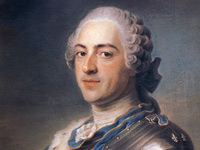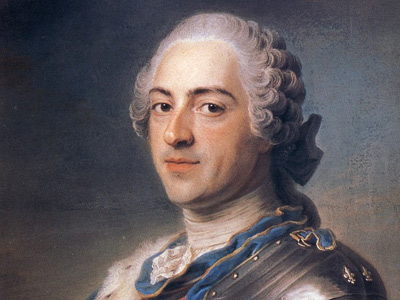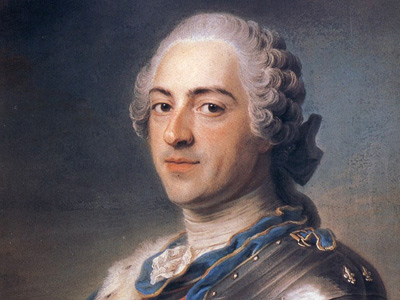Government of the Duke of Bourbon (1723–1726)
On 15 June 1722, as Louis approached his thirteenth birthday, the year of his majority, he left Paris and moved back to Versailles, where he had happy memories of his childhood, but where he was far from the reach of public opinion. On 25 October, Louis was crowned King at the Cathedral of Reims. On 15 February 1723, the king's majority was declared by the Parlement of Paris. officially ending the regency. In the beginning of Louis's reign, the Duke of Orleans continued to manage the government, and took the title of Prime Minister in August 1723, but while visiting his mistress, far from the court and medical care, Orleans died in December of the same year. Following the advice of his preceptor Fleury, Louis XV appointed his cousin Louis Henri, Duke of Bourbon, to replace the late Duke of Orléans as prime minister.
Marriage and Children
One of the first priorities of the Duke of Bourbon was to find a bride for the King, to assure the continuity of the monarchy, and especially to prevent the succession to the throne of the Orleans branch of the family, the rivals of his branch. The 21-year-old Marie Leszczyńska, daughter of Stanisław I, the deposed king of Poland, was chosen. The marriage was celebrated in September 1725 when the king was 15. Between 1727 and 1737, she gave the king ten children, eight girls and two boys, of whom one survived: the Dauphin Louis (1729–1765). The birth of a long-awaited heir, which ensured the survival of the dynasty for the first time since 1712, was welcomed with celebration in all spheres of French society. In 1747 the Dauphin married Maria Josephina of Saxony, who gave birth to the next three Kings of France The Kingdom of France is the historiographical name or umbrella term given to various political entities of France in the medieval and early modern period. It was one of the most powerful states in Europe since the High Middle Ages. It was also an early colonial power, with possessions around the world. Colonial conflicts with Great Britain led to the loss of much of its North American holdings by 1763. The Kingdom of France adopted a written constitution in 1791, but the Kingdom was abolished a year later and replaced with the First French Republic.: Louis XVI, Louis XVIII, and Charles X.
The Kingdom of France is the historiographical name or umbrella term given to various political entities of France in the medieval and early modern period. It was one of the most powerful states in Europe since the High Middle Ages. It was also an early colonial power, with possessions around the world. Colonial conflicts with Great Britain led to the loss of much of its North American holdings by 1763. The Kingdom of France adopted a written constitution in 1791, but the Kingdom was abolished a year later and replaced with the First French Republic.: Louis XVI, Louis XVIII, and Charles X.
The queen was pious and timid, and spent most of her time secluded with her own courtiers. She was a musician, read extensively, and played social games with her courtiers. After 1737 she did not share her bed with the King. She was deeply upset by the death of her son the Dauphin in 1765, and died on 24 June 1768.
Unigenitus, Jansenism and Religious Conflict
One of the first serious conflicts that disturbed the early reign of Louis XV was a battle within the Catholic Church over a Papal Bull called Unigenitus. The Bull was requested by Louis XIV of Pope Clement XI and granted on 8 September 1713. It was a fierce condemnation of Jansenism, a Catholic doctrine based largely on the teachings of Saint Augustine. Jansenism had attracted many important followers in France, including the philosopher Blaise Pascal, the poet Racine, aristocrats including Madame de Sévigné and Madame de Lafayette. The faculty of the Sorbonne, then primarily a theological college and a center of Jansenism, demanded clarification from the government. The Jansenists were allied with the Gallicans, theologians who wanted the Catholic Church in France to be distinctly French. The opposition to Unigenitus was particularly strong among the members of the Parlement de Paris, the assembly of the nobles. Despite the protests, on 24 March 1730 Cardinal Fleury persuaded the King to issue a decree that Unigenitus was the law of France as well as that of the Church.
The government and church imposed repressive measures. On 27 April 1732 the Archbishop of Paris threatened to excommunicate any member of the Church who read the Jansenist journal, Nouvelles Ecclésiastiques. The Parlement was strictly forbidden to discuss religious questions, preventing them from opposing the Unigenitus bull. Priests who did not accept Unigenitus were denied the authority to administer last rites to the dying. A new tax, the cinquantième, was levied against religious figures who had previously been exempted from taxation. Jansenists and Protestants were threatened with prison and banishment. As a result of these repressive acts, religious dissent remained an issue throughout the King's reign.
Tension grew between the Duke of Bourbon and Cardinal de Fleury over the King's favor. The Duke's rigid and cold personality did not appeal to the young King, who turned to his old tutor for advice on how to run the affairs of state. When the King insisted that de Fleury was to be included in all meetings between himself and the Duke of Bourbon, the Duke was infuriated and began to undermine de Fleury's position at court. When the King became aware of the Duke's intrigue, he abruptly dismissed him and replaced him with de Fleury.
HISTORY

RESOURCES
This article uses material from the Wikipedia article "Louis XV of France (1710-1774)", which is released under the Creative Commons Attribution-Share-Alike License 3.0.
© Stories Preschool. All Rights Reserved.











